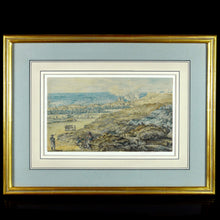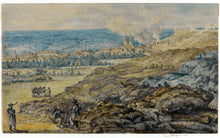The Siege of Badajoz, 1811
- Regular price
- £850
- Sale price
- £850
- Regular price
-
- Unit price
- /per
Adding product to your cart
Overall: 15cm (5.9in) x 25cm (9.8in)
Watercolour on paper. A distant view of Badajoz, the Spanish fortress town on the south western border with Portugal, five times besieged during the Peninsula War. Titled to margin, lower right, ‘Siege of Badajoz, 1811’. The presence of a French infantry and dismounted dragoon in the foreground suggest on of the first three sieges that the town withstood during the Peninsula War.
Read more
In the first two of the five attacks on Badajoz in 1808 and 1809 respectively, the Spanish garrison under José Imazin withstood the French assaults. However, on 10 March 1811, Imazin was bribed into surrendering to a French force under Marshal Soult. A British and Portuguese army, commanded by Marshal Beresford, endeavoured to retake it and on 16 May 1811 defeated a relieving force at Albuera, but the siege was abandoned the following month.
In 1812, Arthur Wellesley, Earl of Wellington (and future duke), again attempted to take Badajoz, which had a French garrison of about 5,000 men. Siege operations commenced on 16 March; by early April, there were three practicable breaches in the walls. These were assaulted by two British divisions on 6 April, reputed to be ‘Wellington's bloodiest siege’, with a loss of some 5,000 British soldiers out of 15,000. After a five-hour onslaught the storming of the breaches failed. The French also lost some 1,200 of their 5,000 soldiers in the battle. Despite the failure at the breaches, the castle and another section of undamaged wall had been attacked and the town was successfully taken by the British. After the capture of the city, the victorious troops (after getting drunk on stocks of captured alcohol) sacked the city, killing and raping numerous civilians. In the view of British historian Ronald Fraser, this was the worst night of the Peninsular War. It took three days before the men were brought back into order. When order was restored some 200–300 civilians had likely been killed or injured. Wellington wrote to Lord Liverpool, ‘The capture of Badajos affords as strong an instance of the gallantry of our troops as has ever been displayed, but I anxiously hope that I shall never again be the instrument of putting them to such a test as that to which they were put last night.’






